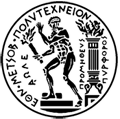
School of Applied Mathematical and Physical Sciense
Physics Department

Professor
Room 004, Physics Building
Tel: +30 210 7722931
Fax: +30 210 7722928
E-mail: aseraf@central.ntua.gr
Research Activities (last twenty five years)
A. Development of Gas and Solid-state lasers (UV & mid-IR)
1. Development of mid-IR solid-state lasers (λ =3.0 μm, Er:YAG)
- Design and development of discharge circuits and optical pumping techniques, optical resonators, Q - switching techniques,
- Stability conditions in optical resonators.
2. Development of chemical vibrational-rotational lasers (HF)
- Development of novel pre-ionization conditions in electro-negative gases (SF6),
- Evaluation of de-excitation rates, simulation of transitions in SF6+C3H8 gases, selection rules,
- Competition phenomena in novel optical resonators, resonator conditions, gain evaluation of chemical reactions.
3. Development of self-terminated lasers (Ν2)
- Population inversion from short lifetime laser levels,
- Novel pumping and pre-ionization techniques for short lifetime laser action (Blumlein, plasma cathode etc.),
- Long pulse durations in self-terminating laser systems.
4. Development of eye-safe lasers (Ar)
- Population inversion in atomic systems of noble gases,
- Laser action beyond the upper limit of the transmission curve of ophthalmic tissues,
- Laser action from low-gain transitions.
5. Double beam laser systems
- Simultaneous laser action in the UV and mid-IR part of the spectrum,
- Double hole burning in gain curves (HF and N2 lasers),
- Simultaneous laser action in the UV and IR part of the spectrum,
- Double hole burning in gain curves (CO2 and N2 lasers).
B. Testing and Evaluation of Optical Fibers and Waveguides (UV-IR)
1. Testing and evaluation of waveguides from Japan. Israel, Greece
2. Testing and evaluation of optical fibers from U.S.A., Canada, Russia, France
C. Laser Applications
1. Short (ns, ps, fs) laser pulses interaction with technological materials.
- Study of material and bio-material properties using short laser (ns, ps, fs) pulses (linear and non linear effects)
2. Stimulated Raman Scattering (SRS) in single-pass high-pressure cells (H2, H2+He, D2) using the Nd:YAG laser as excitation source (355 nm)
- Simultaneous production of multiple laser lines in the UV-VIS (280-500 nm) for biomedical and environmental applications,
- Optimization studies on the SRS technique (H2, H2+He, D2) using the Nd:YAG laser as excitation source (355 nm).
3. Study of electro-optical materials (LiNbO3)
- Q-switching, evaluation of Vλ/2 and Vλ/4 of LiNbO3 crystals,
- Design of novel laser optical resonators under Q – switching.
4. Ablation of biomaterials
- Ablation studies of biopolymers and biomaterials using pulsed CO2, HF, Nd:YAG and Er:YAG lasers
5. Human tissue spectroscopy
- Detection of pathological tissues using Laser Induced Fluorescence techniques,
- Construction of mathematical algorithms for evaluation of the spectra.
6. Industrial Applications of lasers
- Laser triangulation techniques applied in 2D artificial vision for industrial applications,
- Spectroscopy studies of welding arcs for industrial robotic applications.
7. Applications of lasers in cultural heritage
- Laser cleaning of ancient coins, metal artworks, paintings and historical books,
- Evaluation of laser cleaning of ancient coins, metal artworks, paintings and books, using LIF, LIBS, X-RD, SEM, AFM.